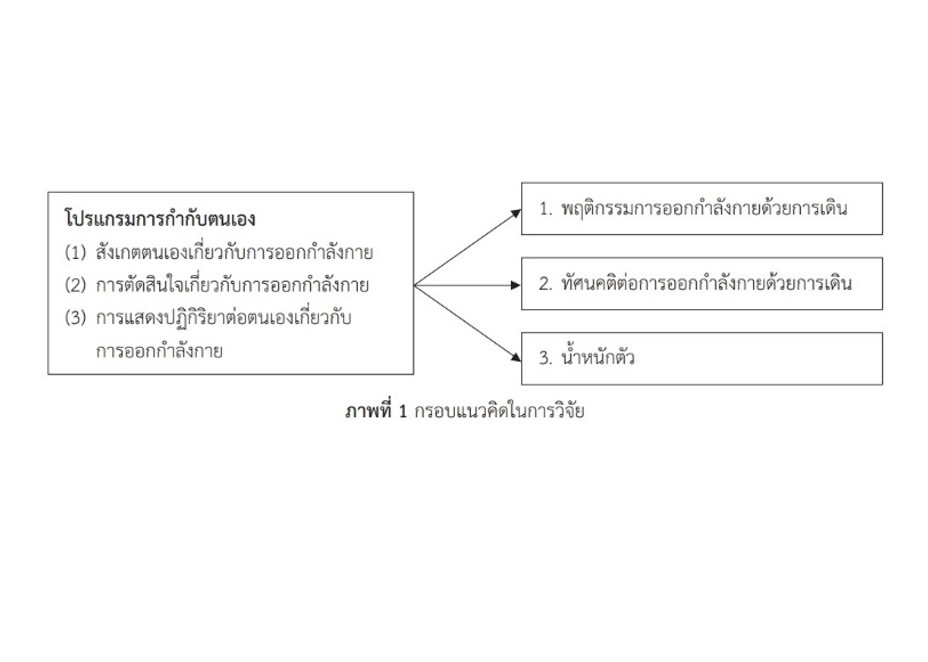ผลของกระบวนการกำกับตนเองต่อ น้ำหนักตัว ทัศนคติ และพฤติกรรม การออกกำลังกายด้วยการเดินของอาสาสมัครสาธารณสุขหญิงที่มีภาวะน้ำหนักเกิน1
คำสำคัญ:
โปรแกรมการกำกับตนเอง , ออกกำลังกายด้วยการเดิน , ทัศนคติ, น้ำหนักตัว , อาสาสมัครสาธารณสุขหญิงบทคัดย่อ
การวิจัยครั้งนี้เป็นการวิจัยแบบกึ่งทดลอง มีวัตถุประสงค์เพื่อศึกษาผลของกระบวนการกำกับตนเองต่อพฤติกรรมการออกกำลังกายด้วยการเดิน ทัศนคติต่อการออกกำลังกาย และน้ำหนักตัวของอาสาสมัครสาธารณสุขหญิงที่มีภาวะน้ำหนักเกิน กลุ่มตัวอย่างเป็น อาสาสมัครสาธารณสุข (อสม.) หญิงที่มีภาวะน้ำหนักเกิน อำเภอบางปะกง จังหวัดฉะเชิงเทรา จำนวน 60 คนซึ่งทำการสุ่มกลุ่มตัวอย่างโดยการสุ่มแบบอย่างง่าย เป็นกลุ่มทดลอง และกลุ่มควบคุม กลุ่มละ 30 คน กลุ่มทดลองได้รับโปรแกรมการกำกับตนเองเป็นเวลา 8 สัปดาห์ ส่วนกลุ่มควบคุมได้รับกิจกรรมการพยาบาลและประชุมอบรมประจำเดือนตามปกติเครื่องมือที่ใช้ในการทดลอง ได้แก่ โปรแกรมกำกับตนเอง เครื่องมือที่ใช้ในการรวบรวมข้อมูลได้แก่ แบบสอบถามข้อมูลทั่วไป แบบสอบถามพฤติกรรมการออกกำลังกายด้วยการเดิน แบบสอบถามทัศนคติต่อการออกกำลังกายด้วยการเดิน และแบบบันทึกน้ำหนักและส่วนสูง วิเคราะห์ข้อมูลด้วยสถิติพรรณนา และการทดสอบค่าที
ผลการวิจัยพบว่า ภายหลังการทดลองกลุ่มทดลองมีค่าเฉลี่ยพฤติกรรมการออกกำลังกายด้วยการเดิน ทัศนคติต่อการออกกำลังกายด้วยการเดินเพิ่มขึ้นมากกว่ากลุ่มควบคุมและกลุ่มทดลองมีน้ำหนักตัวลดลงมากกว่ากลุ่มควบคุม (t = 15.10, p < .05; t = 8.92, p < .05; t = 2.92, p < .05; ตามลำดับ) จากผลการวิจัยมีข้อเสนอแนะว่า พยาบาลสามารถนำโปรแกรมนี้ไปประยุกต์ใช้ส่งเสริมพฤติกรรมการออกกำลังกายด้วยการเดินเพื่อลดน้ำหนักใน อสม. ได้
เอกสารอ้างอิง
Bandura, A. (1986). Social foundation of thought and action: A social of cognitive theory. Englewood Cliffs, NJ: Preentice-Hall.
Bang Pakong District Public Health Office. (2019). Summary of health assessment results in the village health volunteer, ThaKham Subdistrict. Retrieved from http://203.157.123.7/ssobangpakong
Chachoengsao Provincial PublicHealth Office. (2020). Percentage of the population of late working having a normal body mass index Chachoengsao Province. Retrieved from https://cco.hdc.moph.go.th
Chantawat, K., Toonsiri, C., & Rattanagreethakul, S. (2015). Effects of self-regulation program on weight loss behavior and bodyweight among overweight female health care personnel. The Journal of Faculty of Nursing Burapha University, 24(3), 70-81 [In Thai].
Deerotwong, C. (2009). Internal Medicine 2009. Bangkok: Citiprint. [In Thai].
Department of Health . (2007). Metabolic syndrome. Bangkok: Agricultural Cooperative Association of Thailand Printing House. [In Thai].
Department of Medical Services. (2012). Exercise in patients with diabetes and hypertension. Nonthaburi: Institute for Research and Evaluation of Medical Technology. [In Thai].
Elflein, J. (2019). Prevalence of people who were overweight worldwide as of 2019, by age. Retrieved from https://www.statista.com/prevalence-overweight-people.
Ekplakorn, W. (2016). Report of the 5th survey of Thai people's health by physical examination. Bangkok: Graphic and Design Publisher. [In Thai].
Kujapan, J., & Janpech, P. (2019). Effects of exercise program using elastic coconut on improving the balance and movement for the elderly in Pho Chai district, Roi-Et province. Journal of Nursing, Public Health, and Education. 20(3), 119-218. [In Thai].
Kusinitz, I., & Fine, M. (1995). Your guide to getting fit (3rd ed.). California: Mayfield Publishing. Office of the Health Promotion Fund. (2017), February 18). Exercise by “walking” strong body and clear mind. Retrieved from https://www.thaihealth.or.th.
Onsiri, S. (2016). Effect of walking with goal setting on body weight, body fat percentage and physical fitness among Kasetsart University female students. Journal of The Royal Thai Army Nurses, 17(1), 45-53. [In Thai].
Phisprasert, V. (2018). Obesity. Khon Kaen: Klang Nana Wittaya Printing Press. [In Thai].
Pomp, S., Fleig, L., Schwarzer, R., & Lippke, S. (2013). Effects of a self-regulation intervention on exercise are moderated by depressive symptoms: A quasi-experimental study. International Journal of Clinical and Health Psychology, 13(1), 1–8.
Ritchie, H., & Roser, M. (2017). Obesity is one of the leading risk factors for early death. Retrieved from https://ourworldindata.org/obesity.
Rogers, D. (1978). The psychology of adolescence. New York: Appleton Century-Crofts.
Sonthirak, D. (2013). Effect of promoting physical activity through walking based on self-efficacy theory in overweight older adults. Master's Thesis, Gerontological Nursing, Faculty of Nursing, Burapha University. [In Thai].
Thamrangsi, T., Phulkerd, S., & Ponguttha, S. (2011). Why obese? why obesity: situation of factors associated with overweight and obesity in Thai populations. Journal of Public Health, 20(1), 126-141. [In Thai].
Worapongsathron, T. (2000). Principles of research in public health sciences. (4th ed.). Bangkok: Chulalongkorn University Printing House. [In Thai].
World Health Organization [WHO]. (2002). Reducing risks, promoting health life. Geneva: World Health Organization.
World Health Organization [WHO]. (2010). Global recommendations on physical activity for health. Geneva: World Health Organization.

ดาวน์โหลด
เผยแพร่แล้ว
รูปแบบการอ้างอิง
ฉบับ
ประเภทบทความ
สัญญาอนุญาต

อนุญาตภายใต้เงื่อนไข Creative Commons Attribution-NonCommercial-NoDerivatives 4.0 International License.




